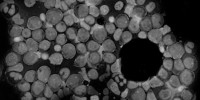
New biomarker for the prognosis of AML
Acute myeloid leukemia (AML) is a malignant and even fatal disease of the hematopoietic system. Since AML is the most common leukemia, it is extremly important to identify reliable biomarkers that reveal something about disease progression: If the severity of the disease course can be assessed, then patients who need more advanced tratment can be identified.
The so-called minichromosome maintenance protein 5 (MCM5), a member of the minichromosome maintenance protein family, is important for cell proliferation and DNA replication. Now researchers have found that high MCM5 levels predict worse outcomes.
Patients with elevated MCM5 levels may need more advanced treatment
In order to better assess the course of the disease and further identify sufferers who may need more advanced treatment, the aim of the study was to investigate prognostic indicators. The datasets of AML patients, including mRNA sequencing data and clinical information, were acquired from the GEO and TCGA datasets. Common methods for survival time analysis (Kaplan-Meier curves and COX regression analysis) were used to identify genes correlated with survival. Furthermore, analyses of biological processes were used to verify the function of various genes.
Results at a glance
Patients with elevated MCM5 level showed a worse prognosis, as shown by the survival analysis. It was indicated through multivariate and univariate analysis that the MCM5 level was an independent adverse prognostic factor for the survival of patients based on GEO and TCGA datasets. In addition, the MCM5 level in AML samples was higher than in normal samples. Furthermore, it was indicated through PPI network and functional enrichment analyses that MCM5 promoted AML progression by accelerating the cell cycle and DNA replication. In conclusion, the MCM5 level was an independent poor prognostic factor in AML patients based on GEO and TCGA datasets. This is the first time that MCM5 has been reported as a biomarker of poor prognosis in AML.
 In conclusion, we demonstrated that MCM5 was an independent prognostic element for AML. Low level of MCM5 was a good prognostic element for AML sufferers. In addition, the results of GO term enrichment, KEGG analysis and PPI network involvement in AML showed that MCM5 may regulate DNA replication and cell cycle of AML cells which provided an insight into the pathogenesis correlated with different MCM5 level.
In conclusion, we demonstrated that MCM5 was an independent prognostic element for AML. Low level of MCM5 was a good prognostic element for AML sufferers. In addition, the results of GO term enrichment, KEGG analysis and PPI network involvement in AML showed that MCM5 may regulate DNA replication and cell cycle of AML cells which provided an insight into the pathogenesis correlated with different MCM5 level.
Find out more about the pathways that should be targeted in the treatment of AML here.